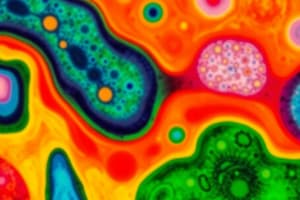Podcast
Questions and Answers
What is the basic unit of life?
What is the basic unit of life?
A cell
What is the study of cell anatomy revealed by an electron microscope called?
What is the study of cell anatomy revealed by an electron microscope called?
Cell ultrastructure
What type of microscope uses beams of electrons to create images?
What type of microscope uses beams of electrons to create images?
- Light microscope
- Atomic force microscope
- Scanning tunneling microscope
- Electron microscope (correct)
What is the primary component of the cell membrane?
What is the primary component of the cell membrane?
The nucleus is the site of cellular respiration.
The nucleus is the site of cellular respiration.
What is the function of the nucleus in a cell?
What is the function of the nucleus in a cell?
Which of the following best describes the function of the nucleolus?
Which of the following best describes the function of the nucleolus?
Which type of electron microscope passes electrons through a specimen?
Which type of electron microscope passes electrons through a specimen?
Which type of electron microscope provides a three-dimensional image of the specimen's surface?
Which type of electron microscope provides a three-dimensional image of the specimen's surface?
Nucleus pores allow both DNA and RNA to pass through.
Nucleus pores allow both DNA and RNA to pass through.
What is the jellylike substance found inside the cell, excluding the organelles?
What is the jellylike substance found inside the cell, excluding the organelles?
What is the main function of mitochondria?
What is the main function of mitochondria?
Mitochondria have their own loop of DNA.
Mitochondria have their own loop of DNA.
What is the function of ribosomes in a cell?
What is the function of ribosomes in a cell?
Where does photosynthesis occur in plant cells?
Where does photosynthesis occur in plant cells?
Chloroplasts have their own loop of DNA.
Chloroplasts have their own loop of DNA.
What is the function of the cell wall in plant cells?
What is the function of the cell wall in plant cells?
What is the primary function of the cell membrane?
What is the primary function of the cell membrane?
Animal cells possess a cell wall.
Animal cells possess a cell wall.
Plant cells contain chloroplasts.
Plant cells contain chloroplasts.
Animal cells contain a large central vacuole.
Animal cells contain a large central vacuole.
Which of the following is NOT a characteristic of a plant cell?
Which of the following is NOT a characteristic of a plant cell?
Which of the following is NOT a characteristic of an animal cell?
Which of the following is NOT a characteristic of an animal cell?
Flashcards
Cell
Cell
A basic unit of life that starts as stem cells and divides to grow.
Cell ultrastructure
Cell ultrastructure
The cellular anatomy revealed by an electron microscope.
Electron microscope
Electron microscope
Microscope that forms an image by focusing beams of electrons onto a specimen.
Phospholipid bilayer
Phospholipid bilayer
Signup and view all the flashcards
Nucleus
Nucleus
Signup and view all the flashcards
Types of electron microscopes
Types of electron microscopes
Signup and view all the flashcards
Nucleus pores
Nucleus pores
Signup and view all the flashcards
Cytoplasm
Cytoplasm
Signup and view all the flashcards
Mitochondria
Mitochondria
Signup and view all the flashcards
Ribosomes
Ribosomes
Signup and view all the flashcards
Chloroplast
Chloroplast
Signup and view all the flashcards
Cell wall
Cell wall
Signup and view all the flashcards
Cell membrane
Cell membrane
Signup and view all the flashcards
Plant cell
Plant cell
Signup and view all the flashcards
Animal cell
Animal cell
Signup and view all the flashcards
Plant vs Animal
Plant vs Animal
Signup and view all the flashcards
Cytosol
Cytosol
Signup and view all the flashcards
Nucleolus
Nucleolus
Signup and view all the flashcards
Cell growth
Cell growth
Signup and view all the flashcards
Cell division
Cell division
Signup and view all the flashcards
Photosynthesis
Photosynthesis
Signup and view all the flashcards
Cellular respiration
Cellular respiration
Signup and view all the flashcards
Prokaryotic cells
Prokaryotic cells
Signup and view all the flashcards
Eukaryotic cells
Eukaryotic cells
Signup and view all the flashcards
Vacuole
Vacuole
Signup and view all the flashcards
Organelle
Organelle
Signup and view all the flashcards
Chromatin
Chromatin
Signup and view all the flashcards
Study Notes
Cell Ultrastructure
- A cell is the fundamental unit of life, originating from stem cells and multiplying to grow.
- Cell ultrastructure refers to the microscopic cellular anatomy observable using an electron microscope.
- An electron microscope forms images by focusing electron beams on a specimen.
- Two main types exist: transmission electron microscopy (TEM) shows a specimen's internal structure and scanning electron microscopy (SEM) creates a three-dimensional view.
- The cell's plasma membrane is a phospholipid bilayer, with embedded proteins, forming a boundary. Phospholipids have water-loving heads and water-fearing tails.
- The nucleus, a crucial organelle, contains DNA (in chromatin form) and RNA, controlling cell growth and reproduction. It's also present in the cytoplasm and includes the nucleolus.
- Nucleus pores permit RNA passage, but not DNA, due to size differences.
- Cytoplasm is the jelly-like fluid in the cell, housing organelles and the cytosol (without organelles).
- Mitochondria are the cell's energy producers, carrying out cellular respiration and possessing their own DNA loop.
- Ribosomes synthesize proteins and lack a surrounding membrane.
- Chloroplasts conduct photosynthesis in plant and algae cells and contain their own DNA loop.
- A cell wall provides structural support in plant cells.
- The cell membrane regulates material passage in and out of the cell, maintaining internal balance and offering cell support and retention.
- Plant cells have a cell wall, chloroplasts, and a large vacuole, unlike animal cells which lack a cell wall or chloroplasts and have a small vacuole.
Studying That Suits You
Use AI to generate personalized quizzes and flashcards to suit your learning preferences.




